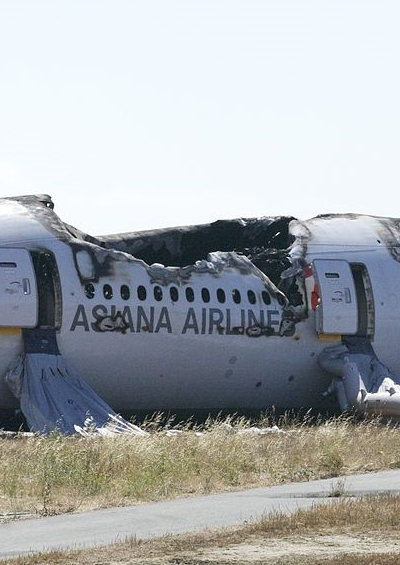When Do Planes Crash?
During which phase of flight do most fatal commercial aviation accidents occur?
March 28, 2015

The crash of Germanwings Flight 9525 — along with recent accidents involving Malaysian and Indonesian jetliners — has focused the world’s attention on airline safety.
We wonder: During which phase of flight do most fatal commercial aviation accidents occur?
A. While taxiing on the runway
B. During takeoff and climb
C. While cruising
D. During descent and landing
A. “While taxiing on the runway” is not correct.
According to a 2014 study of commercial aviation accidents by aircraft manufacturer Boeing that covered most makers and countries, 10% of all fatal aviation accidents over the last decade occurred while the planes were on the ground. When these accidents happened, the planes were either taxiing, unloading or loading passengers and baggage, being towed or parked.
Because these accidents generally occur when the aircraft is parked or moving a very low speed, this is unsurprisingly the safest phase of aircraft operation for passengers inside the plane. In fact, only one passenger was killed during a taxiing accident over the past ten years.
However, before the standardization of ground safety measures, the danger was greater. In 1977, in Tenerife, Canary Islands, a Boeing 747 that was taxiing on the runway collided with another 747 during its takeoff. The fiery collision claimed nearly 600 lives and remains the deadliest accident in aviation history.
Most fatalities during this stage of flight operations involve crewmembers who are working on the tarmac around the aircraft.
For the ten-year period of 2004-13, Boeing documented altogether 72 fatal aviation accidents involving large commercial aircraft manufactured in all countries (except, due to a lack of operational data, those of the former Soviet Union).
B. “During takeoff and climb” is not correct.
Taking off and climbing to cruising altitude is the second-most dangerous period of operations for commercial aircraft, according to Boeing’s study.
Between 2004 and 2013, 16 of the 72 fatal aviation accidents occurred during this phase of the flights. They accounted for 22% of all fatal accidents (excluding those aircraft manufactured in Russia or the former Soviet Union).
Taking off and climbing involve three distinct phases, according to aviation experts.
The takeoff phase occurs when the plane is accelerating down the runway, while the initial climb is the steep ascent as the plane leaves the ground, followed by a gentler climb to cruising altitude.
Over the past ten years, six fatal accidents occurred during takeoff, four during the initial climb, and six during the climb-to-cruising altitude phase.
One such crash occurred in July 2000, when an Air France Concorde struck debris on the runway at Charles de Gaulle Airport in Paris, causing a catastrophic explosion shortly after takeoff.
C. “While cruising” is not correct.
Of the 72 fatal aviation accidents that occurred between 2004 and 2013, seven — or 10% — occurred while the plane was cruising at altitude. Along with when the plane is parked or taxiing on the runway, the cruising phase of the flight is the period when fatal aviation accidents are least likely to occur.
Considering that cruising is by far the lengthiest of the operational phases (accounting for 57% of the duration of a 90-minute flight and much higher for longer flights), it is arguably the least accident-prone phase of flying.
When accidents do occur during this phase, however, they are far more dangerous for passengers. The seven fatal accidents documented in Boeing’s study resulted in 774 fatalities — or 20% of the 3,884 fatalities in commercial aviation accidents from 2004 to 2013.
The disappearance of MH370 over the Indian Ocean in March 2014, the shooting down of MH17 over Ukraine in July 2014 and the Germanwings flight in March 2015 were three notable incidents that occurred while the aircraft were cruising.
However, neither of these fatal incidents would be included in Boeing’s study if they had fallen within the study period. Boeing’s data excludes fatalities resulting from crashes due to sabotage, hijacking, terrorism or military action.
If Germanwings Flight 9525 was deliberately crashed by its co-pilot, as authorities now believe, it will be the seventh suspected pilot suicide in the last 33 years of commercial aviation history, according to data provided by the Flight Safety Foundation.
D. “During descent and landing” is correct.
The point at which the aircraft begins to descend from its cruising altitude in preparation for landing marks the beginning of the phase in which most fatal aviation accidents occur. Between 2004 and 2013, 58% of the fatal accidents documented by Boeing occurred during descent, approach and landing.
As with accidents that occur when the plane is cruising, these accidents tend to be catastrophic. The 42 accidents — caused by mechanical failure or by pilot error — claimed 2,226 lives, accounting for 58% of all commercial airline fatalities.
Nevertheless, air travel maintains a significant safety advantage over other modes of transportation. Based on preliminary statistics from the National Transportation Safety Board, road travel accounted for 94% of the 34,678 transportation-related deaths in the United States in 2013.
By comparison, air travel accounted for 443 deaths, or barely 1% of the total. Only three of those were caused by the crash of a large commercial airliner (Asiana Airlines Flight 214, which landed short of the runway in San Francisco).
But while airplane crashes are increasingly rare events, airlines have resisted efforts such as requiring flight data to be livestreamed from the plane to data centers on the grounds that the amount of data would be overwhelming or prohibitively costly to transmit and store. In addition, pilots associations have raised privacy concerns about cockpit video recordings.
Takeaways
The crash of Germanwings Flight 9525 has focused the world’s attention on airline safety.
10% of all fatal aviation accidents over the last decade occurred while the planes were on the ground.
22% of all fatal airline accidents have occurred during the “takeoff and climb” phase.
The descent, approach and landing phase of a flight is by far the most dangerous.

